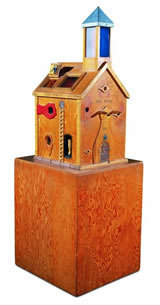H. C. Westermann
dal 20/11/2007 al 1/3/2008
Segnalato da
20/11/2007
H. C. Westermann
Cantor Arts Center, Stanford
Dreaming of a Speech Without Words. The 40-plus paintings and early objects on view, dating from 1949 to 1962, focus on a pivotal period in Westermann's career. This reflects Westermann's earnest desire to express through his art what he found difficult or impossible to verbalize.

Paintings and Early Objects
This is the exhibition’s final venue and only West Coast appearance. The 40-plus works on view, dating from 1949 to 1962, focus on a pivotal period in the career of this influential artist.
The exhibition title refers to a quote from Hermann Hesse’s Steppenwolf, “We . . . are all dreaming of a speech without words that utters the inexpressible and gives form to the formless.” This reflects Westermann’s earnest desire to express through his art what he found difficult or impossible to verbalize. Westermann (1922–1981), explaining his fine-art studies at The School of the Art Institute of Chicago, wrote in a 1954 letter to his sister that he “had something to say.”
Over time that “something” proved to have a great deal to do with the traumatic experiences he had survived as a gunner aboard the USS Enterprise in World War II and as a combat infantryman in the Korean War. One of the recurrent themes of Westermann’s art is the horror and futility of war. His works also include social and political commentary and employ humor to depict anxieties and powerlessness.
He combined elements of Surrealism, Expressionism, and Pop Art, with an understanding of the art of children and the “low art” of comic books to create expressive works of fine art. Although his initial ambition was to become a painter, he became best known as a sculptor, using assemblage as well as traditional techniques and materials such as plywood, galvanized metal, linoleum, and rare woods. Unlike other exhibitions of Westermann’s work, which have focused exclusively on his sculpture or his printmaking, this presentation illustrates the connections among his paintings, works on paper, and three-dimensional objects.
The full-color catalogue that accompanies the exhibition features an added section of testimonials from diverse contemporary artists whom Westermann has influenced. “Westermann is an ‘artist’s artist.’ He generated enthusiasm among his peers and subsequent generations of artists,” said Hilarie Faberman, Cantor Arts Center curator of modern and contemporary art. For example, Ed Ruscha, one of several artists who contributed to the exhibition catalogue, wrote, “He injected muscle and grit into each of his created works so the result always screamed the successful results of truth, anger, and humor.
The exhibition catalogue includes essays by Michael Rooks, Dennis Adrian, and David McCarthy. The exhibition was organized by The Contemporary Museum, Honolulu, and curated by Michael Rooks. Its presentation is made possible through the generous support of Mary and Roy Cullen, Ruth P. Horwich, and Sharon and Thurston Twigg-Smith. In-kind support has been provided by ResortQuest Hawaii, formerly Aston Hotels and Resorts and Horizon Lines, LLC. This exhibition is dedicated to Walter Hopps.
The exhibition’s presentation at the Cantor Arts Center is made possible by the Halperin Exhibitions Fund.
The Center is located on the Stanford campus, off Palm Drive at Museum Way. Parking is free after 4 p.m. and all day on weekends. Information: 650-723-4177
Image: H.C. Westermann, Mad House, 1958.
Opening November 21, 2007
Cantor Arts Center
Stanford University 328 Lomita Drive and Museum Way, Stanford
Wednesday – Sunday, 11 am – 5 pm, Thursday until 8 pm.
Admission is free



